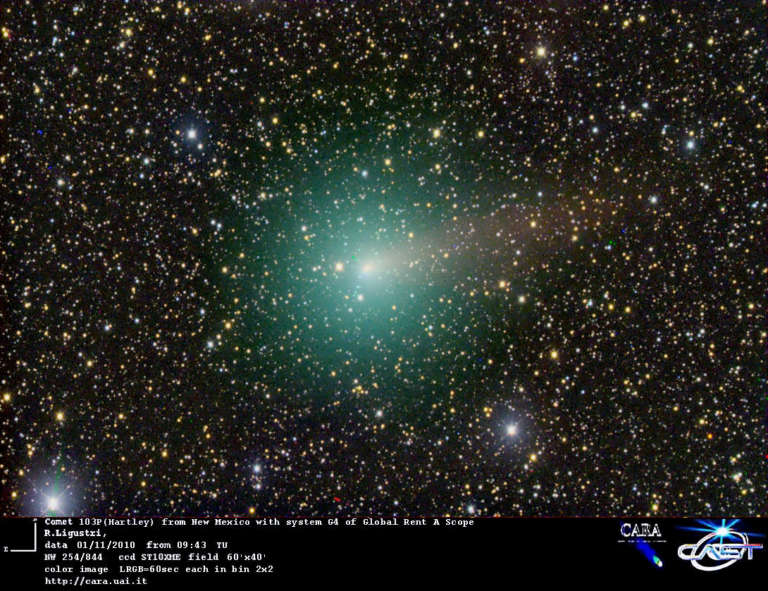Emily Lakdawalla • Nov 01, 2010
Three days until Deep Impact's encounter with Hartley 2
The week is finally here: Deep Impact flies past Hartley 2, the smallest comet yet to be visited by a spacecraft, on Thursday, November 4 at 13:50 UTC. Most of my writing and Tweeting this week will probably be about this event! To remind you of what's to come, see my Deep Impact Hartley 2 encounter timeline and my writeup of last week's preview press briefing.
Hartley 2 passed through perihelion 3 days ago, and had its nearest approach to Earth on October 20, so amateur astronomers are producing amazing views of it right now. Here's just one awesome photo; Daniel Fischer posted a blog entry today full of links to this one and many more, and I suspect his blog and Twitter feed will be full of more beautiful Earth-based pictures of Hartley 2 all week.

Here's the most recent view of Hartley 2 that's available from the Deep Impact website, but it's a week old -- I suspect they'll post a new one today or definitely tomorrow, and it'll be much more impressive. This photo does not enlarge; the Deep Impact team is preferring highly frequent images to large images so that they can monitor the outbursts of material from the comet. They save only the middle 256-pixel-square area of each image from their camera, saving space for more photos; it's quite enough area to reveal the coma's structure and dynamics.

The Deep Impact science team is gathered now at JPL, watching all the latest images and spectra come in. Check out the mission blog (which unfortunately does not have an RSS feed, but new posts are mentioned on Twitter) for daily updates and snapshots of the team in "action" (I put "action" in quotes because the action mostly consists of staring at computer screens -- but honestly it is very exciting seeing the team gathered together, watching new data stream in!)
To help you visualize what's going on, I highly recommend checking out JPL's new Eyes on the Solar System website, which is a really thrilling 4D simulation of pretty much everything that's going on, about to go on, or has already happened in robotic space exploration (at least that part of robotic space exploration for which the programmers at JPL could get their hands on detailed trajectory information). It is tremendously fun to use Eyes on the Solar System to follow along with the Voyagers and Pioneers, but today I'll recommend you bring up the "Destination" menu at left, select Deep Impact at Hartley 2 or Tempel 1, and spin time back and forth to see the encounters.
Tomorrow, there's going to be a UStream webcast of a public lecture given by Malcolm Hartley, the discoverer of the comet. It's at November 2 at 19:00 PDT / November 3 at 02:00 UTC (sorry so late for you all in Europe, but public talks in L.A. have to allow time to people to get to the venue after work)! Stay tuned to this blog for the latest from Deep Impact, and check out the timeline for what to look forward to!

Support our core enterprises
Your support powers our mission to explore worlds, find life, and defend Earth. You make all the difference when you make a gift. Give today!
Donate

 Explore Worlds
Explore Worlds Find Life
Find Life Defend Earth
Defend Earth

